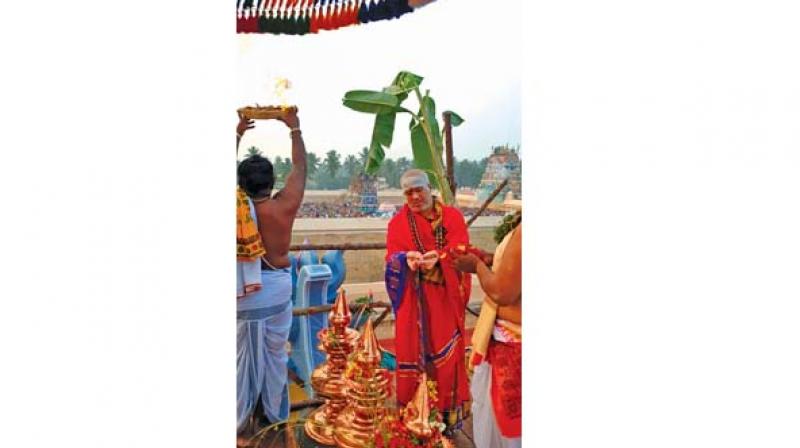Chennai: Kumbhabhishekams done to 765 temples

Chennai: Kumbhabhishekam (also known as Samprokshanam) is not merely a once in a 12-year ritual where priests chant mantras and sprinkle sanctified water. The entire ceremony is aimed at energising the deities installed within the temple and also safeguard the structure and area around from lightening strikes.
Kumbha means the head and denotes the shikhara or crown of the temple. Normally, this is the gopuram and abhisekham or prokshanam is the ritual bathing.Kumbhabhishekam is widely celebrated as a grand festival in South India. And the Hindu Religious and Charitable Endowments (HR & CE) department has ensured the conduct of the ceremony in 10,566 temples till March this year since 2011. During 2017-2018 alone, tiruppani (renovation) was carried out and kumbabhishekams were performed in 765 temples, which is considered as a record number.
“This is the most important ceremony of making the living structures called temples vibrant. The kalasam at the top of temple towers (in the form of inverted pot, with pointed head facing the sky) needs to be periodically renewed. This is samprokshanam or kumbhabhishekam as it centres around the kalasams,” says Sri Paramahamsa Bharadwaj Swamy of Sri Yohamaya Bhuvaneswari Peetam, Ambattur, who had installed the deities and performed kumbhabhishekam for over 400 temples in South India.
Among the kumbahishekam, the one performed at the renowned Sri Jambukeswarar Akilandeswari Temple at Tiruvanaikoil in Tiruchy on Dec. 12, is unique, he says. “Here Goddess Akilandeshwari is Amsa Devatha of Sri Varahi. Adi Shankara performed the Sri Chakra thadanga pratishta to reduce the wrath of the Goddess. Also, Her blessings enabled me to write over ten books including Saptasadi and Vancha Kalpa Ganapati puja,” the 61-year- old swamy says.
According to temple sources Goddess Akilandeshwari is worshipped by devotees for good education and
intelligence, marriage and boon for children are fulfilled. By coming around the fifth divine wall known as “Thiruneetran thirumathil one gets the boons fulfilled. Lord Siva, represents the element of water here. Thirugnana Sambanthar, Appar, Sundarar, Arunagirinathar, Iyyadigal Kadawarkon, Thayumanavar have sung the glory of Lord Jambukeswarar in their literary works. Goddess Akilandeswari blessed poet Kalamega Pulavar with the talent to write poems at this temple.
At a tender age of 18, Sri Bharadwaj accompanied his father, and wrote 1.25 lakh nama parayanam of Ambal at the temple.

